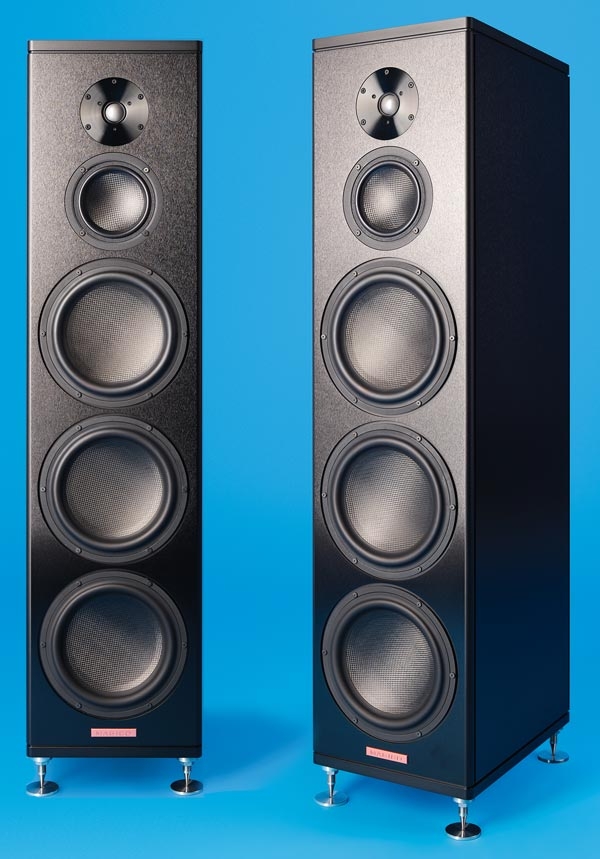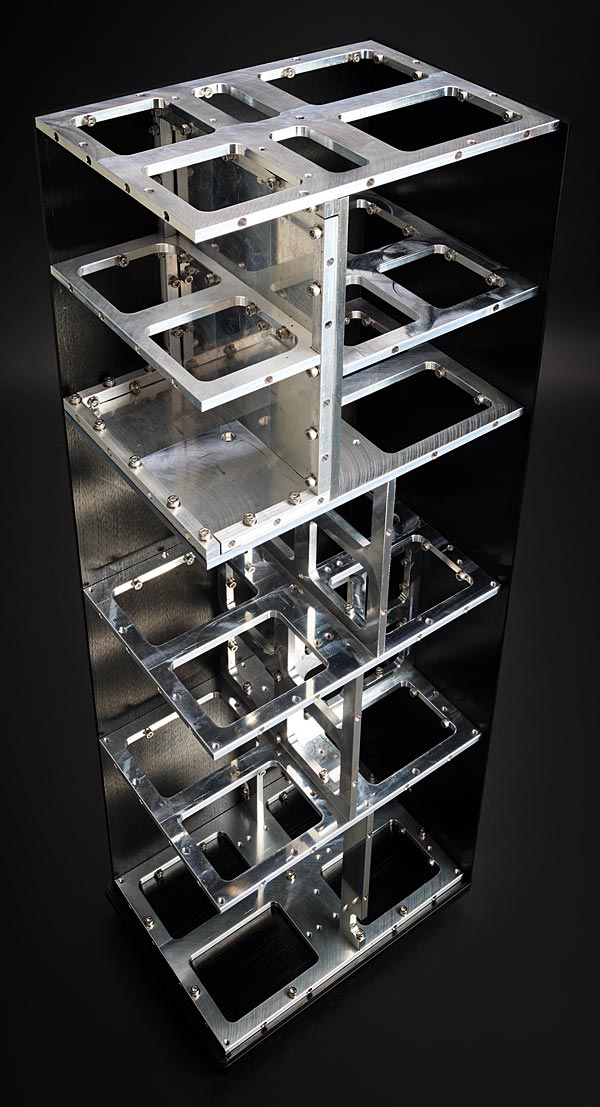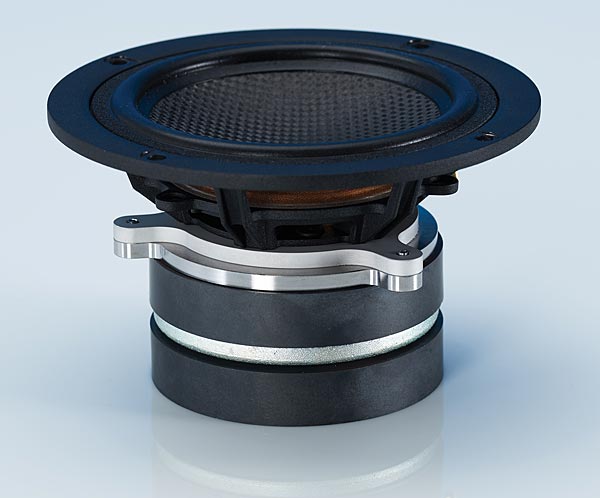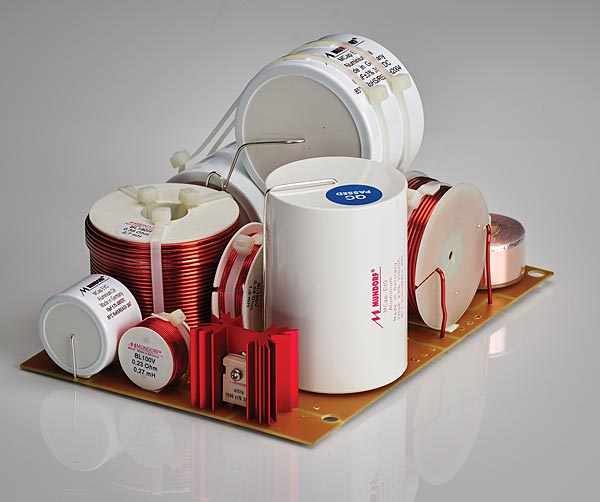| Columns Retired Columns & Blogs |
Something that competes with the Revel Salon 2, Price and performance wise

At $63,600/pair equipped with the no-longer-optional M-Pod footers (footnote 1), the now-departed M2 costs roughly 2.5 times what the newly arrived A5 costs. (The A5 comes with mere spikes.) Like all current Magico speakers, both are sealed-box, acoustic suspension designs, which means that at the bottom end, the response falls off at 12dB/octave—slow enough to have useful output a full octave below where the low bass starts trending down. That's a much slower rolloff than with the more common bass-reflex (ported) designs.
The A5 is the bigger speaker of the two, with significantly more cabinet volume, which should translate into more and deeper bass—as should the A5's three 9" woofers, which, doing the math, have about 2.5 times more woofer surface area than the M2's two 7" bass drivers.
Magico is a company that measures and that practices physics-based design based on established psychoacoustic knowledge. But it is also a company that listens; sure, Magico owns a Klippel Near Field Scanner and a laser interferometer, but it also has the second-nicest listening room I've visited. Science and listening need not be opposed concepts, even if, regrettably, some people seem to see it that way. Where Magico parts ways with some of the more subjectivist loudspeaker makers is in their belief that a product that measures well should also sound good. But that doesn't keep them from listening.
While some well-regarded loudspeakers have intentionally (or unintentionally) lively cabinets, a scientific approach to loudspeaker design requires that cabinets be acoustically inert. It's desirable for a loudspeaker to dissipate some of the resonant energy of the air vibrating inside the cabinet, but the cabinet itself is not the best dissipator, because at least some of the energy absorbed by a cabinet will be released as sound after a time delay; that's distortion. Absorbing energy is what mineral wool and other cabinet-stuffing material is for. Energy absorbed by those materials is dissipated as heat.
The M2 achieves its cabinet-wall inertness via carbon fiber, which is very stiff and relatively light. Stiffness means it does not absorb vibrational energy readily; low weight means it doesn't store much energy. (In the M-series speakers, most of the cabinet is carbon fiber, but the top and bottom caps are aluminum.) Carbon fiber makes it expensive and labor-intensive to manufacture and to finish. Apparently, you can buy a giant chunk of aluminum alloy and machine it for much less.

The A5 cabinet is made from the same aircraft-grade, precipitation-hardened aluminum alloy used in Magico's Q-series speakers. Tempered aluminum alloy is heavier than carbon fiber, but it's stiff, with an advantageous ratio of stiffness to weight, which helps suppress internal resonance—as does the "complex internal bracing" (quoted from the Magico website) inside.
Aluminum makes some people think lightweight and crinkly, like foil or an aluminum can. But the A5's aluminum chassis is massive, thick and hard. When I rapped my knuckles against the cabinet to try to detect cabinet resonances, I hurt my knuckles. The only appreciable vibrations I noticed were in my bones. This speaker is 180lb of mostly metal.
The tweeter and the midrange driver are each mounted in their own sealed chamber. Magico's Alon Wolf told me that the A5's 5" driver is the first true, pure midrange driver ever to grace a Magico speaker; apparently, the 6" drivers used in other Magico speakers extend into the upper bass. (Incidentally, the A5's 5" driver comes very close to being 6".)
Just as science-based designers want stiff enclosures, they also want stiff driver cones, for roughly the same reasons: They want their cones to move in and out, not to flex and vibrate internally. For years—I don't know how long—Magico has used "Nano-Tech" drivers which coat their cones with graphene. Graphene is a high-tech material that's lightweight and extraordinarily stiff—so stiff that its Young's modulus (a measure of stiffness) is hard to measure, but it's somewhere around 1TPa or about 15 times stiffer than aluminum.

The A5 may be part of Magico's least-expensive range, but it is, or was, the first Magico speaker to adopt a particular innovation: an "aluminum honeycomb core" in their driver cones. This was planned to be introduced with the flagship M9, but the A5 was ready first so got the nod. All the drivers in the A5 (except the tweeter of course) utilize this new cone construction. It's exactly what it sounds like. The "honeycomb core" is said to make the A5's graphene-coated cones even stiffer and lighter, which makes it more likely that they will operate (in their passband) in a purely "pistonic" manner: just moving in and out without vibrating internally. The M9, now that it's finished, also has this cone technology.
There's more to a driver than a cone, however: Wolf told me that overall, the M-series drivers are more sophisticated than the drivers on the A5—another reason the M-series speakers cost more.
Very stiff driver cones often come with steep-slope crossovers, because once they start to break up, they do so violently. It's best, therefore, to operate them strictly in the frequency range where they're not breaking up. Typically for Magico, the A5 utilizes, on the low-pass side, "elliptical-symmetry" crossover filters, a topology that's able to achieve very steep rolloff with a low parts count. And because elliptical filters have "zeros," or "notches"—points where the impedance is effectively infinite—they're very good, when designed well, at eliminating especially problematic frequency ranges. (I don't know whether this characteristic is important in Magico's designs.)
The A5 is also the first Magico speaker—Magico says it's the first loudspeaker anywhere, and I've got no reason to doubt it—to use Mundorf's new "MResist Ultra" foil resistors. Magico says they offer "greater power handling, transparency and liquidity." The other crossover parts are also all from Mundorf.

I almost forgot the tweeter: It's "based on the fundamental design platform and geometry of the M-series tweeters," but the 28mm beryllium diaphragm lacks the diamond coating, which, in the more expensive speaker, adds additional stiffness but very little weight.
Cheaper than cheese
All that is factual; I should add my personal, subjective take on the A5's physical package. In size, it's big but not huge. It is, however, imposing. It emanates gravity—that sense of massiveness—in much the way that Egyptian pyramids do, or Alpine cliff faces (although obviously on a smaller scale). Touch it, spend time around it, and you're impressed with its substance. Aluminum has famously low heat capacity, yet I swear these speakers took three days to warm up completely after they were brought in off the truck midwinter. (As they warmed up, their sound changed dramatically.)
For all that, though, the metal enclosure is beautifully anodized to a seemingly durable eggshell-sheen finish that's available—to repeat the Ford Motor Company cliché and frequent Stereophile trope—in any color as long as it's black. With its nonshiny black paint, the A5 also emanates darkness—and here, to be clear, I am not talking about the sound. Nothing is shiny on this speaker other than the stiletto spikes (which aren't all that shiny), and there's a bit of a sheen on the machined tweeter surround. Otherwise, the A5 is a place where photons go to die. Which I like.
Drivers are bolted on, the screws exposed (the better to tighten them if they get loose). There's a single pair of high-quality binding posts—no provision for biwiring or biamping. If the boxy A5 seems utilitarian, it's an aesthetic many will appreciate. My wife, who loves nice, natural wood, likes this package, finding it preferable to some shiny wood veneers, which can sometimes look fake even when they're real.

Something that competes with the Revel Salon 2, Price and performance wise

... the $25000 Magico A5 versus that of the $1200 Wharfedale Linton Heritage whose frequency response was described by JA1 as being "superbly flat"?
https://www.stereophile.com/content/wharfedale-linton-heritage-loudspeaker-measurements

Looking at the specs, and as JA points out, these speakers require an amp that doesn’t have a problem driving a 2ohm load! How many amps have no problem driving a 2ohm load??

... rated output of 400W/ch into a 2 ohm load.
https://parasound.com/2250-v2.php
Price is a mere $999.
https://www.audioadvisor.com/prodinfo.asp?number=PAC2250V2

The Parasound amps in their more expensive lines (above your example) would be also work in those 4-2 ohm loads, and be a much better match sonically and power-wise.
At this speaker's price point, there are a ton of amp choices that would work fine... more so in that point of the market than on the mid-level or entry-level end. It's part and parcel to moving up in many areas of performance, and should be a no-brainer here.

Parasound amps don't like running below 4 ohm ( JC-1’s no problem ) much , it would not be my choice for this Magico model Speakers ...!
Regards

... capable of 900W into a 2 ohm load.
Need more?
According to a Hi-Fi News test, the JC5 is capable of 1680W into a 2 ohm load.

Safe to say that most every tube amp out there would be excluded. Why these speakers have such a brutal low impedance drop is really the question?

... have 2 ohm taps on the output transformer.
The MC1502 can output 240W/ch into a 2 ohm load at 1% distortion.

I had noticed the mention of titanium voice-coils in the magazine article, so I checked Magico's marketing web page and confirmed that also mentions titanium voice-coils. I suspect that might be an error, and was waiting for the article to appear here to comment on that.
The voice-coil and voice-coil former/bobbin are two different things serving two different purposes. The voice-coil is a wound coil of electrical wire. The voice-coil former/bobbin is the structural tube that the voice-coil is wound around and structurally connects to the diphragm and to the suspension spider. The structural voice-coil former/bobbin might be made of titanium, but the voice-coil very probably is not wound using titanium wire since titanium is a relatively poor electrical conductor relative to copper which is commonly (but not always) used in voice-coils.

Punchy on bass region, but doesn't go deep on the sub bass region (~40hz is the best?), I have expected more for 3 x 9" woofers. The 2-ohm requirement and 86db sensitivity would make anyone want to buy these speakers spend more money to make the speaker 'sing' effortlessly. Revel Salon 2 is better in term of performance/measurement, but it has been discontinued.

"I have not shown the in-room response below 45Hz, as this was affected by the presence of subsonic noise from his building's heating/ ventilation system. This could not be turned off on the morning that I was able to perform the measurements"
The Salon 2 is still available..
https://www.revelspeakers.com/products/types/floorstanding/Salon2-.html

Many rush to judgment without even hearing them, let alone trusting the professional.

Its 86db with 2 watts , so actually its only 83db with 1 watt , so think of using 300 watts/ch to get the best out of these ....!
Regards

….and can heartily concur with this review. Had Q3’s in the past and these wonderful speakers easily exceed those worthy speakers. Extraordinary fidelity at low levels but can do “concert” levels if the house or neighbours allow.
Added the SPods as a measure of safety as we now live in a condo.

I cannot think of excellent audio engineering of a speaker with an impedance as low as this one. Considered that the phase angels are pretty mean in the bass region, where enrgy in music often is high, doesn´t make things better.
And then the massive amount of delayed sound on the waterfall plot?
What makes this loudspeaker excellent engineering?
The waterfall plot should actually mirror the stiffness of the cabinet, but it doesn´t at all.
To me a reasonable impedance combined with a reasonably uncorrected linear progress, will make almost any amplifier perform better, and a clean waterfall plot is paramount for transparancy in speakers.
It seems like none of these qualities are found in this speaker.

I assume it’s mass must store the energy and release it slowly , has always been an issue with mass loading it stores energy, part of the reason some speaker manufacturers prefer light mass construction
Having heard these , they are very impressive for the money when I heard them, in fact I thought they must be more expensive than they are
Being a sealed design, they drop off slower than ported designs per octave, and will have generally less room interactions, the fact they got 20 hertz in room audible, a feat in itself given the relative loudness is much lower at this frequency, unless they were hearing the second harmonic ?
Pass amplifiers seem to work very well with Magico, but would have been interesting to have tried with the Gryphon essence which are a scale above the Pass in my experience

I wasn't hearing 40Hz. In fact, that's a pretty hard mistake to make listening to descending warble tones.
Jim Austin, Editor
Stereophile

Indeed! Most modern amps will have no issue. We use Pass X150.8 to driver these beauties. These are not much different then most other speakers reviewed here lately (Focal, Wilson etc.)

Are you kidding? Where are the highs above 10Khz?!

.. The less important the last octave becomes, and on top of that, The teenagers who can hear the last octave can't afford them, so...
But still, from an engineering standpoint, I agree.

"As with the Magico M2 that I reviewed in February 2020 and JCA reviewed in March 2021, the use of a pistonic tweeter with a high-Q ultrasonic dome response results in a lack of energy in the region below that resonance.

..that are extremely linear well beyond 20khz, let alone 10khz, but I've never seen one this linear below 12khz.

I would suspect that this speaker would be a total no no for any tube amp out there. Pity that a lot of competent speakers these days are such a bear to drive, requiring a significant outlay to not only buy the speaker in question, but also the monster amps to drive them!

…is what Jim Austin didn’t mention at at all: how the A5 compares to the M2 he just spent a year with, and which cost 2.5x as much. Given how much audio writers tend to emphasize that the more expensive sibling really is worth it, even when praising a low priced overachiever, JA2’s silence on this point says it all. The A5 either betters the M2, or equals it.
To me it’s still completely academic, I will never buy speakers this expensive, but if I did have 24K to put into speakers, this one would be on my list to audition.